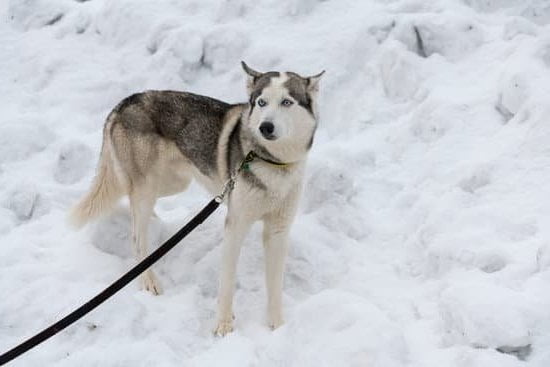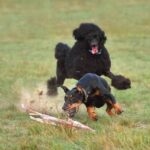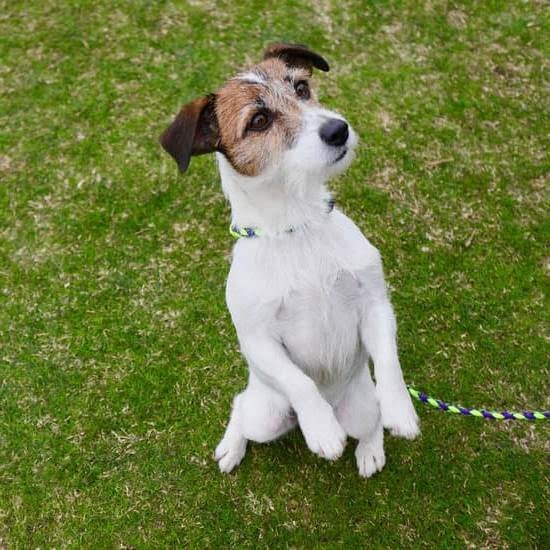Are you wondering how to train your young dog not to jump on people? Jumping on people can be a common behavior in young dogs, but with the right training and techniques, it can be corrected. In this article, we will explore effective methods for training your young dog to refrain from jumping on people.
Understanding why young dogs jump is essential in addressing and correcting this behavior. It could be a way for them to seek attention or simply out of excitement when greeting people. By understanding the underlying reasons for their behavior, you can implement appropriate training methods to discourage jumping.
Training a young dog not to jump is crucial for their development and well-being, as well as for the safety and comfort of those around them. Building a strong foundation with basic obedience training is key in teaching your dog to follow commands and behave appropriately around people. Additionally, using positive reinforcement techniques and consistency in enforcing boundaries will help shape their behavior positively.
In the following sections, we will delve deeper into these training methods and explore how redirecting your dog’s energy, managing interactions with guests and strangers, seeking professional help when necessary, and addressing any underlying behavioral issues all play a role in successfully training your young dog not to jump on people.
The Importance of Training a Young Dog Not to Jump
Training a young dog not to jump on people is essential for their safety and the comfort of those around them. Jumping can lead to accidents, especially with children or elderly individuals who may not have the balance or strength to withstand a dog’s enthusiastic greeting.
Additionally, uncontrolled jumping behavior can be intimidating for some people, potentially causing fear or anxiety around dogs. By teaching a young dog not to jump, you are not only preventing potential harm but also promoting positive interactions between your pet and others.
Moreover, training a young dog not to jump is crucial for fostering good manners and obedience. A well-behaved dog is more likely to be welcomed in various social situations and public spaces. This can enhance your relationship with your pet and allow you to enjoy many activities together without worrying about disruptive behavior. Establishing good manners early on also sets the stage for further training and prevents future issues from developing as your puppy grows into an adult dog.
In addition to safety and social considerations, training a young dog not to jump provides mental stimulation and physical exercise. Instead of relying on jumping as a way of greeting or expressing excitement, your pet can learn alternative behaviors that are both more appropriate and satisfying for them.
Redirecting this energy in positive ways encourages mental engagement and helps prevent boredom, which can lead to destructive habits in dogs. Overall, preventing jumping through proper training contributes significantly to the overall well-being of your pet while improving their relationships with humans.
| Importance of Training | Benefits |
|---|---|
| Safety | Prevents accidents and discomfort |
| Good Manners | Promotes positive social interactions |
| Mental Stimulation | Redirects energy in positive ways |
Building a Strong Foundation With Basic Obedience Training
Importance of Basic Obedience Training
Basic obedience training provides young dogs with structure and boundaries, helping them understand what is expected of them. By learning to obey commands, they become more attentive and responsive to their owner’s instructions. This not only helps in preventing jumping but also sets the stage for addressing other behavioral issues that may arise as the dog grows older.
Positive Reinforcement Techniques
Using positive reinforcement techniques during basic obedience training can be particularly effective in discouraging jumping behavior. When a young dog learns to associate good behavior with rewards such as treats, praise, or playtime, they are more likely to repeat that behavior. For instance, rewarding the dog for sitting calmly when greeting people can help replace jumping with a more desirable action. Training should always focus on rewarding desired behaviors rather than punishing unwanted ones.
By establishing a strong foundation through basic obedience training and incorporating positive reinforcement techniques, pet owners can effectively teach their young dogs not to jump on people. This approach not only addresses the immediate issue of jumping but also promotes overall good behavior and manners in the long run.
Using Positive Reinforcement Techniques to Discourage Jumping
When training a young dog not to jump on people, positive reinforcement techniques can be highly effective. Dogs respond well to rewards and praise, making it an ideal method for discouraging jumping behavior. One technique is to ignore the dog when they jump and only give them attention or affection when they have all four paws on the ground.
When the dog refrains from jumping, immediately reward them with verbal praise, a treat, or a favorite toy. This helps the dog associate not jumping with positive outcomes.
Consistency is key when using positive reinforcement techniques. It’s important for all family members and visitors to follow the same approach in order for the training to be effective. Additionally, using a cue word such as “off” or “down” can help the dog understand what is expected of them. By consistently rewarding the desired behavior and providing clear cues, the young dog will begin to understand that not jumping is more rewarding than jumping.
Another effective positive reinforcement technique is clicker training. This method involves using a clicker to mark the exact moment when the dog performs the desired behavior, followed by a reward such as a treat. This precise marking of good behavior helps the young dog understand what action led to the reward, accelerating their learning process.
| Positive Reinforcement Technique | Effectiveness |
|---|---|
| Ignoring jumping and rewarding calm behavior | Highly Effective |
| Consistency and Clear Cues | Key for Success |
| Clicker Training | Accelerates Learning Process |
Consistency Is Key
When it comes to training a young dog not to jump on people, consistency is key in establishing and enforcing boundaries. Dogs thrive on structure and routine, so it’s important to set clear expectations and consistently enforce them. This means that everyone in the household should be on the same page when it comes to allowing or discouraging jumping behavior.
One way to establish boundaries is by using basic obedience commands such as “sit” or “down.” Teach your dog these commands and use them consistently whenever they greet people. By requiring your dog to sit or lie down before receiving attention, you are setting a clear boundary that jumping is not an appropriate way to greet people.
Enforcing boundaries also means being firm and consistent with your reactions to jumping behavior. Avoid inadvertently reinforcing the behavior by pushing the dog away, yelling, or using physical force. Instead, calmly and firmly redirect your dog’s behavior by asking them to sit or removing them from the situation if they continue to jump. By consistently enforcing these boundaries, you are teaching your dog that jumping is not acceptable behavior when greeting people.
Redirecting Your Dog’s Energy and Attention
Redirecting a young dog’s energy and attention is an important aspect of training them not to jump on people. Many times, dogs jump as a way of seeking attention or releasing excess energy. Therefore, redirecting their focus onto something else can be very effective in curbing this behavior.
Interactive Toys and Games
One way to redirect your dog’s energy is by engaging them in interactive toys and games. This can include puzzle toys that dispense treats when manipulated or playing games like fetch or tug-of-war. By providing mental and physical stimulation, you can help your dog release their energy in a more appropriate manner.
Training Commands
Another method of redirecting your dog’s attention is through training commands. Teach your dog basic obedience commands such as “sit,” “stay,” and “down.” When your dog starts to jump, use these commands to redirect their focus onto following the command instead. This not only redirects their energy but also reinforces discipline and respect for authority.
Physical Exercise
Ensuring that your young dog gets enough physical exercise is crucial in managing their behavior. Regular walks, runs, or playtime at the park can help burn off excess energy, making them less likely to jump out of excitement. Additionally, mental stimulation through training and activities like agility courses can also redirect their focus and keep them mentally engaged.
By implementing these techniques for redirecting your dog’s energy and attention, you can effectively train them not to jump on people while fostering a well-behaved companion.
Managing Interactions With Guests and Strangers
Young dogs can often become a little too excited when interacting with guests and strangers, leading to jumping behavior. It is important to manage these interactions in a way that teaches the young dog appropriate behavior without causing any undue stress. Here are some tips for managing interactions with guests and strangers:
- Leash your dog: When guests or strangers come over, keep your young dog on a leash to have better control over their behavior. This will also prevent them from jumping up on people.
- Ask for cooperation: Inform your guests or strangers of your dog’s training needs and ask for their cooperation in not engaging with the dog if they jump up.
- Provide an alternative greeting: Teach your dog an alternative behavior, such as sitting or offering a paw, that they can perform when greeting people. This can redirect their attention away from jumping.
Consistent management of interactions with guests and strangers is crucial in reinforcing the training efforts aimed at discouraging jumping behavior in young dogs. By implementing these strategies, you can help create positive experiences for both your pet and the people they interact with.
Remember, patience is key as it may take some time for your young dog to fully understand what is expected of them when greeting guests and strangers. With practice and positive reinforcement, you can help them learn appropriate behavior during these interactions.
Seeking Professional Help When Necessary
When you have tried every technique and tip you can find, but your young dog still won’t stop jumping on people, it might be time to seek professional help. Professional trainers and behaviorists can provide expert guidance and support to address the issue and modify your dog’s behavior successfully.
Here are some indicators that it may be time to seek professional help:
- Your dog’s jumping behavior is becoming increasingly aggressive or difficult to manage.
- Previous training methods have not been effective in curbing the jumping behavior.
- You are unsure of how to adjust your training approach or need personalized assistance.
Professional trainers and behaviorists can work with you and your young dog to develop a customized training plan tailored to your specific situation. They can assess the underlying reasons for your dog’s jumping behavior and create a structured program to address it effectively.
Remember, seeking professional help shows dedication to providing the best care and training for your young dog. With the right guidance, you can overcome this challenge and enjoy a well-behaved and well-mannered companion for years to come.
Addressing Any Underlying Behavioral Issues
Sometimes, jumping can be a symptom of underlying behavioral issues in young dogs. It’s essential to address any potential problems that may be causing your dog to exhibit this behavior.
If basic obedience training and positive reinforcement techniques are not yielding the desired results, it may be time to consult with a professional dog trainer or behaviorist. They can help assess your dog’s overall behavior and provide specialized guidance for addressing any underlying issues that may be contributing to the jumping behavior.
Some possible underlying behavioral issues that could contribute to a young dog’s tendency to jump on people include anxiety, fear, overexcitement, or lack of socialization. A professional can help identify these issues and work with you to create a tailored training plan that addresses the specific needs of your dog. By targeting the root cause of the jumping behavior, you’ll be able to effectively modify your dog’s behavior and foster a more positive relationship with them.
In some cases, addressing underlying behavioral issues may also involve making adjustments to your dog’s environment or daily routine. This could include providing more mental and physical stimulation through toys and exercise, creating a safe space for your dog to retreat when feeling overwhelmed, or implementing strategies for reducing their overall stress levels.
By taking a holistic approach to addressing any underlying behavioral issues, you can help your young dog overcome their jumping habit and become a well-adjusted member of your family.
Conclusion
In conclusion, training a young dog not to jump on people is essential for their development and safety, as well as for the comfort of those around them. By understanding the reasons behind their jumping behavior, pet owners can tailor their training methods to effectively discourage this habit. Building a strong foundation with basic obedience training and using positive reinforcement techniques are crucial in teaching young dogs the appropriate way to interact with people.
Consistency is key when it comes to enforcing boundaries and redirecting a dog’s energy and attention. When managing interactions with guests and strangers, it’s important to set clear expectations for your dog’s behavior and ensure that they remain calm and well-mannered. Seeking professional help may be necessary in some cases, especially if there are underlying behavioral issues that need to be addressed.
With patience, dedication, and the right training approaches, pet owners can enjoy the company of a well-behaved and well-mannered young dog. By following these guidelines and addressing any jumping behavior early on, both the dog and those around them can have positive and fulfilling interactions. Ultimately, the goal is for young dogs to learn how to greet people appropriately without jumping, leading to happier relationships between pets and their owners.
Frequently Asked Questions
Why Do Young Dogs Jump on You?
Young dogs often jump on people as a way of greeting or showing excitement. It is a natural behavior for them, and they may not realize that it can be perceived as inappropriate or overwhelming. They may also jump as a way to get closer to your face to show affection.
Should You Knee Your Dog When They Jump?
Kneeing your dog when they jump is not recommended as a method of training. It can potentially harm the dog and may escalate the jumping behavior. Instead, positive reinforcement training techniques such as rewarding calm behavior, ignoring jumping, and redirecting their attention to an appropriate behavior are more effective in addressing this issue.
How Do I Stop My Dog From Being Excited With Visitors?
To stop a dog from being overly excited with visitors, it’s essential to work on their impulse control and obedience training. Teach them commands like “sit” or “stay” and practice these in different scenarios, including when visitors arrive.
Additionally, desensitizing your dog to the sight of visitors approaching by using treats and positive reinforcement can help them remain calm and composed during interactions with guests. Consistency and patience are key in modifying this behavior.

Welcome to the blog! I am a professional dog trainer and have been working with dogs for many years. In this blog, I will be discussing various topics related to dog training, including tips, tricks, and advice. I hope you find this information helpful and informative. Thanks for reading!





